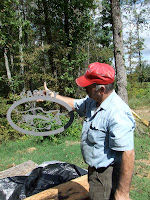As I glanced around the small wooden cottage, built almost
50 years ago on the edge of beautiful Lake Claiborne, there was not a single
square inch that did not contain some sort of artistic endeavor created by its
owner, Mrs. Glenda Tooke. Glenda,
a native of Claiborne Parish, decided that she was going to make her retirement
years count by creating art.
Her art, which ranges from gourds to cypress knees, to emu eggs, and
many things in between, reveals the love she feels for her family and her
community. Within each tiny
treasure, is hidden a little bit of the history of Claiborne Parish and the
connections this parish has with the families that grew up there. Listening to Mrs. Tooke recite the
stories behind each piece, had the effect of creating a personal timeline that
enabled me to capture a glimpse of times gone by.
 |
| Cotton patch gourd |
Glenda’s art reflects snapshots of the quiet, everyday
moments so reflective of the lifestyle found in this small rural
community. Her natural talent
reflects the culture and environment of northwest Louisiana with a simplicity
that exposes how even the most mundane activity can have monumental value in
the eyes of others.
Glenda not only creates art for herself, but shares her talent with others by forming the
only organized gourd patch group in Louisiana, called the Lake Claiborne Gourd
Patch, which is a member of the American Gourd Society. This group, which uses its time to
share ideas and explore the technique and art of gourding with each other, also
succeeds in forming a bond of friendship that only the arts can provide.
Besides being talented in visual arts, Glenda is also artistically
inclined in music. In 1993, Tooke
asked her husband, David, for a mandolin for Christmas. She spent the next year in the back
bedroom with her mandolin, instruction book, and a tape, learning to play. This so-called “retirement project” has
opened up a world of music that has become part of her life. She plays with a group of local
musicians, whose calendar stays booked well in advance.
It seems a shame that Glenda’s art is not available for the
public to see, but she mainly creates art for her own enjoyment, as well as
serving as a connection with her family and community. Her involvement in the arts has led to
a retirement lifestyle that is even busier, yet seems more fulfilling, than her
earlier way of life. When
asked what her next arts activity will be, she gave a little wink and told me,
“whatever comes along… you just never know what’s around the corner.” I do know that this creative lady has
not yet accomplished everything of which she is capable, and cannot wait to see
what is next on her list.









